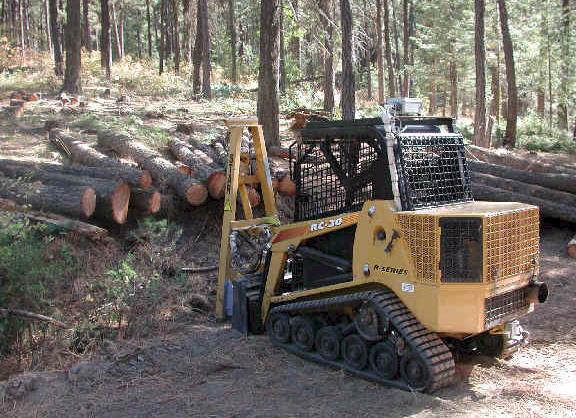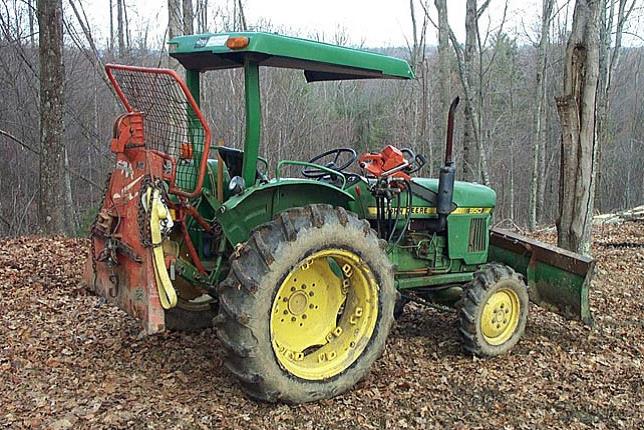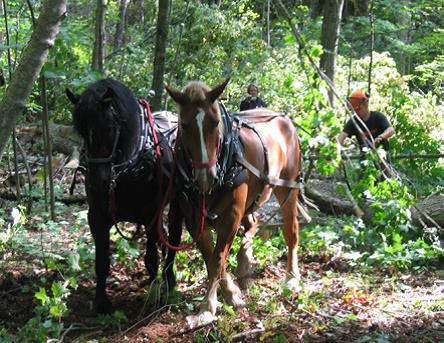Introduction
Small-scale timber harvesting systems, including those that can handle woody biomass, are becoming more attractive to the forestry community. A number of non-conventional, small-scale timber harvest systems have emerged that have the physical capability to harvest or recover woody biomass. However, for these systems to be feasible, they must also meet several other criteria. Environmental impacts, safety and cost effectiveness are especially significant. In addition to a brief description of small-scale biomass harvesting and recovery systems, this fact sheet provides information on their advantages and disadvantages.
Small-ScaleSystems
Mechanized. Today, many timber harvest machine manufacturers are designing and manufacturing smaller scale equipment. In a recent trade publication, for example, six manufacturers advertised harvesting attachments and carrier modifications for farm tractor or skid steer machines. Nine manufacturers offered smaller scale chippers for timber harvesting (1) (Image 1). Characteristics of an optimum small-scale timber harvest system include safety features, low capital cost, low transportation cost, low overhead, maneuverability, minimal access requirements, ability to optimize quickly, and ability to deal with small-diameter or irregular shaped woody material (2).

Image 1. Small Tracked Skid Steer source: Forest Products Department, University of Idaho
Small-scale timber harvesting systems use either a single machine or two machines. In a single machine system, one machine handles all the bunching, forwarding/skidding, and loading. In two-machine systems, the first machine handles felling and possibly processing, while a second machine completes the skidding or forwarding and loading. Examples of single machine systems include small, modified agricultural tractors, small skid steers, and small excavators. Examples of two-machine timber harvest systems would be a small harvester and tractor or a small harvester and forwarder (Image 2). Small, independent contractors or even landowners could get into the biomass gathering business using small-scale equipment with little capital investment. It would require having a working arrangement with a local end-user to take the woody biomass they gather. In addition, it would require a working arrangement with a trucker to get the biomass to the end-user. Often, it is difficult to find a willing trucker because small-scale operations do not produce enough volume to attract professional truckers with proper licenses. Small-scale timber harvesting systems with lower capital costs optimize at lower levels of productivity (3). However, it is rarely economically feasible to use small-scale systems to harvest lower valued material on less productive cuts (i.e. harvests as a result of uneven-aged silviculture, timber stand improvement [TSI], and other improvement cuts (4). Small-scale timber harvesting systems may be more appropriate to collect woody biomass alongside conventional equipment that harvests and collects more conventional products like pulpwood and sawlogs. In addition, the environmental impacts of small-scale systems remain questionable, primarily soil compaction, rutting, and erosion.

Image 2. Modified Agricultural Tractor source: Harry Groot, BRFC
Additionally, small-scale timber harvesting systems tend to attract inexperienced or not as well trained operators, are more labor intensive, and may have problems meeting OSHA logging safety requirements (4). Safety standards currently lacking in many small-scale timber harvest systems include OSHA-approved roll bars, reinforced belly pans, liquid-filled rear tires, radiator guards, valve stem protection, engine guards, cab protection, safety glass, and hydraulic tanks (4). Some small-scale timber harvesting systems have been modified for forestry operations, including the addition of falling object protective structures.
Animal Power. Using livestock for commercial timber harvesting (i.e. animal logging by horse, mule, and oxen) is uncommon in the southern U.S. but not unheard of. Landowners having specialized objectives may want to consider this option (4). One example may be site improvement with collection of woody biomass as a secondary goal. In countries where labor costs are low, the cost of animal skidding for small tree harvesting, particularly in thinning operations, is lower than machine skidding. However, this is not true in the southern U.S., where labor costs are relatively high. Moreover, animal logging systems are more sensitive to severe weather conditions than machine skidding and have trouble with skidding distances greater than 500 feet due to low ground speed and recovery time. In addition, animal logging requires specialized support equipment and special sets of operator skills and experience (5). About 50 animal powered logging operations currently exist in the Southeast (Image 3). Using animal powered logging systems depends upon local availability and, in most cases, a landowner’s willingness to learn or pay for such services.

Image 3. Animal Powered Operation source: Tat Smith, University of Toronto
Summary and Conclusions
Although gaining in popularity, small-scale timber harvesting systems are often costly when harvesting less valuable woody material on smaller tracts. In addition, questions arise concerning the environmental sustainability and safety of such systems. Nevertheless, using small-scale timber harvesting systems may be a feasible option to recover woody biomass at the same time as using conventional timber harvesting equipment to harvest and recover pulp and sawlogs. Small-scale timber harvesting systems can be successful in some situations, using prudent planning and highly skilled operators to carry out such systems.
Endnotes
1 Forest Products Equipment. 2005. St. Johnsbury, VT: MRP Publishing, 14(2).
2 Wilhoit, J.; Rummer, B. 1999. Application of small-scale systems: evaluation of alternatives. ASAE Paper No 99–5056. St. Joseph, MI: American Society of Agricultural Engineers.
3 Updegraff, K.; Blinn, C.R. 2000. Applications of small-scale forest harvesting equipment in the United States and Canada (Staff Paper Series No. 143). St. Paul MN: University of Minnesota, Minnesota Agricultural Experiment Station and College of Natural Resources.
4 Visser, J.M.; Hull, R.B.; Ashton, S.F. 2006. Mechanical Vegetative Management. In: Monroe, M.C., L.W. McDonell, and L.A. Hermansen-Baez (Eds.). 2006. Changing Roles: Wildland-Urban Interface Professional Development Program. Gainesville FL: University of Florida.
5 Rummer, B. 1996. Niche. Technical Paper 97-P-9. Rockville, MD: American Pulpwood Association.
